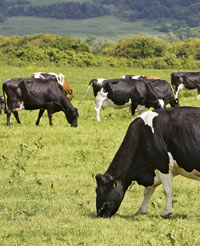Prepare for turnout now

Staying ahead of the game when it comes to grass management is vital, according to DairyCo extension officer Piers Badnell. He says once grass gets away from you it controls you, and you can spend all season playing catch up and not getting the full grazing potential.
With that in mind, Mr Badnell has put together a best practice list together when preparing for turnout.
1. Test the soil
To achieve full potential grass needs a healthy suitable soil to grow in, pH6-6.5 with P and K indices of two.
2. Look at soil compaction
Dig into the top 15cm, compaction from stock will be in the top 5cm, machinery from 10-15cm. If the soil is compacted then you reduce yield potential, and it is unlikely to drain properly, also reducing its ability to carry stock.
3. Check for worms
Worms are a sign of a healthy soil, so throughout the season, every now and again, dig a hole in a cube of earth about 30x30cm and check how many healthy and vigorous worms you can see.
4. Walk the grass early
This is imperative, even if your cows are not out you should have an idea of what is happening so you can react straight away.
5. Look closely at the grass
Grass starts growing at soil temperatures of 5C so it will grow most of the year. Look at it now so that you are not turning cows out into really heavy covers. Grazing a little early is much better than too late which only leads to wastage and subsequently poor quality grass.
6. Use rotational grazing
This increases the efficiency of the grass roots in capturing moisture and nutrients from the soil, and helps prolong growth through dry periods. It also allows you to measure the quantity of grass available and so more accurately match supply and demand which increases utilisation, and reduces waste.
7. Graze to 5cm
This reinvigorates the plant encouraging new tillers and maintaining quality. Without it, dead materials and stalks will build up and reduce quality and palatability. It is not always possible to achieve, so you need to use techniques to regain that 5cm residual. For example, if you have a poor residual after grazing consider silaging in the next round, or let the grazing ground freshen again for a couple of weeks and then graze hard with heifers.
